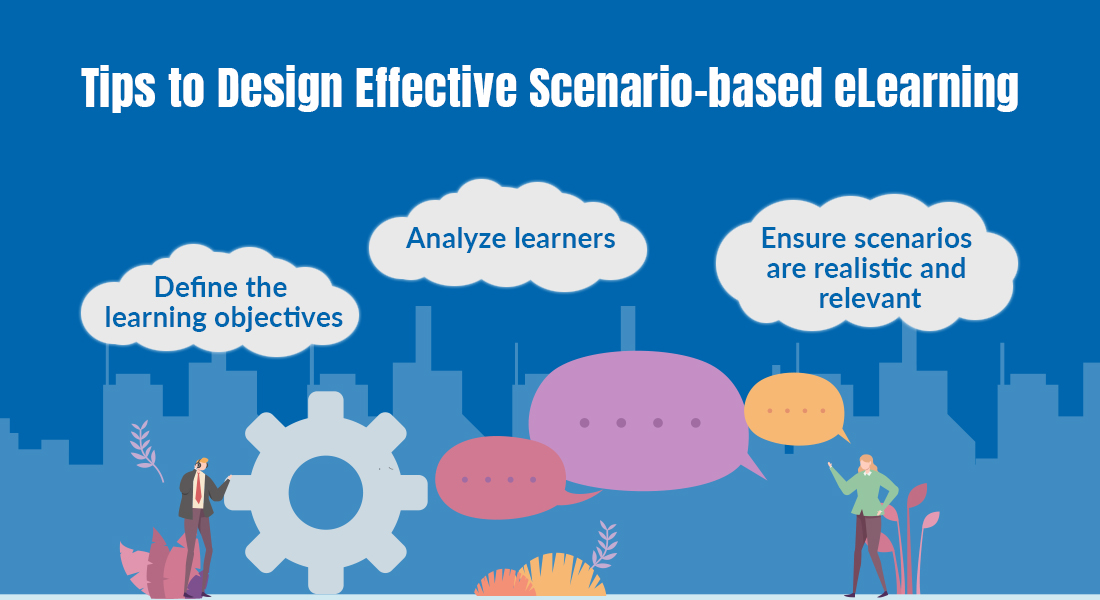4 Reasons to Love Scenario-Based Learning for Corporate Training

Scenarios can make learning more engaging, effective, and real, adding life to the eLearning courses. Scenario-based learning is one such strategy that helps to drive performance improvement by making training more immersive and engaging. With the help of scenario-based learning, learners practice a skill using interactive, virtual, and problem-solving contexts. They can learn by facing realistic challenges in a risk-free and close-to-the-real-world environment.
Will Scenario-Based Learning Lead to Better Training?
Here Are Reasons to Say Yes to Scenario-Based Learning
- It is Engaging, Fun, And Experiential
- It is Realistic and Application Based
- It Helps in The Identification of Potential Risks
- It Leads to Better Retention
Now, it is not always possible for learners to have exposure to every possible work situation. Through scenario-based learning, hypothetical situations are created, giving learners a chance to assess their responses to them. Scenario-based learning is a popular instructional design strategy that can make eLearning courses learner-centric by applying an active-learning approach. It mirrors work-related situations, giving learners an opportunity to apply their prior experience, subject knowledge, and critical and logical thinking to tackle a work problem effectively.
Akin to scenario-based learning, there are other instructional design strategies that are very popular.
Explore more about such instructional design strategies for engaging eLearning courses.
Why Say Yes to Scenario-Based Learning?
1. It is Engaging, Fun, And Experiential
Scenario-based learning makes learning more fun and engaging. Learners are motivated and hence it helps them to retain and comprehend the content easily. Learners can experiment in hypothetical real-life scenarios, without any risk or consequences of their actions. There is better learner participation and engaging them becomes much easier.
2. It is Realistic and Application Based
Scenario-based situations are created to be realistic but risk-free for learners. It is true that you learn better when you apply your knowledge and skills. Learners’ problem-solving ability improves. Scenario-based learning gives them an opportunity to explore various work-related situations and ways to tackle them.
Scenario-based learning is an application-based learning approach. Learners face similar real-life situations and apply the learned knowledge or acquired skills and assess the outcome. Scenario-based learning makes the other formats of online training more effective. For instance, if we ask learners to take an online course, and then apply the acquired knowledge in a risk-free real-world situation, what they learned now becomes more effective. Learners now know what to do in a similar kind of situation.
3. It Helps in The Identification of Potential Risks
Because learners get a hands-on experience of various scenarios, they tend to have a better understanding of the implications. It is easy for learners to confront fears that otherwise they might not do when facing a real situation. Scenario-based learning prepares the learners for the potential risks and ways to avoid them.
4. It Leads to Better Retention
When you tackle a situation, you tend to remember it for a longer duration. Learning is best used when applied during a situation. Through scenario-based learning stories like events are replicated for learners to practice their skills. This leads to better retention of knowledge. The situations that learners deal with are memorable and stick with them for a long time.
Scenario-based learning offers many such advantages. It is an immersive training environment where learners are active participants from the beginning to the end of the course. As the business environment is ever-changing, and in such a dynamic environment there are no two similar scenarios. Every employee might face a different situation that requires different responses. Here are a few types of scenarios based on their purpose.
Types of Scenarios Based on Purpose
Exploratory Scenario (What Might Happen)
It is a situation where you have to make learners think of many possible outcomes, which have more than 1 correct answer. With exploratory scenario-based learning, you want your learners to think through each solution and provide feedback accordingly. They are encouraged to assess and think through each scenario that sticks to their mind. It is better than simply telling them what is wrong or right. It works well for exploratory or behavioral training.
Normative Scenario (How to Reach a Specific Outcome)
In normative scenario-based learning, there is a clearly defined outcome, there is one correct option. It is ideal when you have to let learners know what exactly needs to be done in a particular situation to get a certain result. It works well for training in which the learner needs to synthesize information and put it together to reach a given outcome.
Predictive Scenario (What Will Happen)
Predictive scenario-based learning is important for the learners to know what is bound to happen as the next step in a given scenario. It lets learners know about definite results if they select a specific option. Such scenarios work well in predicting the long-term effects of a given situation.
Scenarios are used to imitate real-world situations. While designing scenario-based eLearning courses, different types of scenarios are kept in mind. Based on purpose and responses to different scenarios, courses are created to make sure that learners experience learning as realistically as possible.
Parting Thoughts
I hope this blog helps provide a few benefits of scenario-based learning and the types of situations your learners might face. Scenarios impact learning dramatically, you can utilize them to make learning memorable. Scenario-based learning, when used right will help you with many types of corporate training like sales training, compliance training, soft skills training, etc., and make training more effective and realistic. It is very engaging and immersive, and your learners will take away solutions to deal with different work situations.
Well, that’s not all, scenario-based learning stimulates critical thinking and helps learners see things beyond the obvious. Are you curious to know more? Through this webinar recording explore more about scenario-based learning.



![5 Tips for Effective Scenario-based Learning [Infographic]](https://blog.commlabindia.com/hubfs/Imported_Blog_Media/scenario-based-learning-design-tips-info.jpg)

